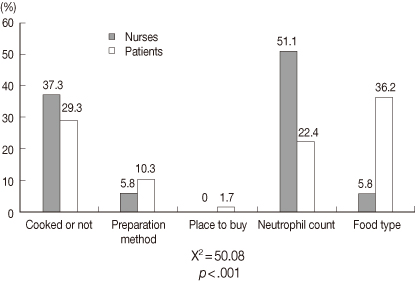Asian Oncol Nurs.
2012 Dec;12(4):331-338. 10.5388/aon.2012.12.4.331.
Comparison of Perception of the Neutropenic Diet between Nurses and Patients
- Affiliations
-
- 1Department of Nursing, Pusan National University Hospital, Busan, Korea. davidesder@hanmail.net
- 2Pusan National University College of Nursing, Busan, Korea.
- KMID: 2168799
- DOI: http://doi.org/10.5388/aon.2012.12.4.331
Abstract
- PURPOSE
This descriptive study aimed to compare the perception of the acceptable foods for the neutropenic diet between nurses and patients by food type.
METHODS
The participants were 225 nurses working at chemotherapy wards and 71 patients in chemotherapy treatment. Data were collected with a self-administered questionnaire from January 2 to February 24, 2012, and analyzed with SPSS 12.0 program using descriptive statistics and the chi2-test.
RESULTS
Eighty-eight point eight percent of nurses and 76.1% of cancer patients thought the patients needed the neutropenic diets. The most important decisional criteria to determine dietary restriction was neutrophil count for nurses and food type for patients. The two groups showed significantly different allowance to raw fruits and raw vegetables, sterilized canned juice, fried vegetables, yogurt, uncooked tofu, salted fish, cooked fish, cooked shellfish, uncooked grain powder, jellified food, home-made bread/cookies, nuts including peanuts, instant coffee or tea and tea brewed. In general, patients were more permissive about the neutropenic diet than nurses.
CONCLUSION
It is recommended to consider patients' preference as well as nurses' professional knowledge and publish standardized clinical diet guidelines for neutropenic patients with collaboration between nurses and patient representatives.
Keyword
MeSH Terms
Figure
Cited by 2 articles
-
Factors associated with Oncology Nurses' Adherence to Chemotherapy-Induced Neutropenia Guidelines based on Pender's Health Promotion Model
Gyeong-Jin Kim, Ja Yun Choi
Korean J Adult Nurs. 2019;31(4):389-402. doi: 10.7475/kjan.2019.31.4.389.Knowledge of and Compliance with Neutropenic Diet in Patients with Hematologic Malignancy undergoing Chemotherapy
Ok Kyung Jeon, Yeon Hee Lee, Myung Hee Kim
Asian Oncol Nurs. 2018;18(2):75-85. doi: 10.5388/aon.2018.18.2.75.
Reference
-
1. Kim NJ, Choe KW. Infections in neutropenic patients. J Infect Chemother. 2000. 18:369–377.2. Barber FD. Management of fever in neutropenic patients with cancer. Nurs Clin North Am. 2001. 36:631–644.3. Restau J, Clark AP. The neutropenic diet: Does the evidence support this intervention? Clin Nurse Spec. 2008. 22:208–211.4. French MR, Levy-Milane R, Zibrik D. A survey of the use of low microbial diets in pediatric bone marrow tranplant programs. J Am Diet Assoc. 2001. 101:1194–1198.
Article5. Smith LH, Besser SG. Dietary restrictions for patients with neutropenia: A survey of institutional practices. Oncol Nurs Forum. 2000. 27:515–520.6. Todd J, Schmidt M, Christain J, Williams R. The low bacteria diet for immunocompromised patients. reasonable prudence or clinical superstition? Cancer Pract. 1999. 7:205–207.7. DeMille D, Demin P, Lupinacci P, Jacobs LA. The effect of the neutropenic diet in the outpatient setting: A pilot study. Oncol Nurs Forum. 2006. 33:337–343.
Article8. Moody K, Finlay J, Mancuso C, Charlson M. Feasibility and safety of a pilot randomized trial of infection rate: Neutropenic diet versus standard food safety guidelines. J Pediatr Hematol Oncol. 2006. 28:126–133.
Article9. Henry L. Immunocompromised patients and nutrition. Prof Nurse. 1997. 12:655–659.10. Moody K, Charlson ME, Finlay J. The neutropenic diet: What's the evidence? J Pediatr Hematol Oncol. 2002. 24:717–721.
Article11. Bauer J, Capra S, Ferguson M. Use of the scored patient generated subjective global assessment (PG-SGA) as a nutrition assessment tool in patients with cancer. Eur J Clin Nutr. 2002. 56:779–785.
Article12. Kubrak C, Jensen L. Critical evaluation of nutrition screening tools recommended for oncology patients. Cancer Nurs. 2007. 30:1–6.
Article13. Leuenberger M, Kurmann S, Stanga Z. Nutritional screening tools in daily clinical practice, the focus on cancer. Support Care Cancer. 2010. 18:S17–S27.
Article14. Lis CG, Gupta D, Lammersfeld CA, Markman M, Vashi PG. Role of nutritional status in predicting quality of life outcomes in cancer: a systematic review of the epidemiological literature. Nutr J. 2012. 11:27.15. Wilson BJ. Dietary recommendations for neutropenic patients. Semin Oncol Nurs. 2002. 18:44–49.
Article16. Gardner A, Mattiuzzi G, Faderl S, Borthakur G, Garcia-Manero G, Pierce S, et al. Randomized comparison of cooked and noncooked diets in patients undergoing remission induction therapy for acute myeloid leukemia. J Clin Oncol. 2008. 26:5684–5688.
Article17. Jeon OK, Yim SE, Jeong IS, Yun EY, Kim MH, Park YS, et al. Survey on dietary restrictions for neutropenic patients. J Korean Oncol Nurs. 2010. 10:210–217.
Article18. Maskarinec G, Murphy S, Shumay DM, Kakai H. Dietary changes among cancer survivors. Eur J Cancer Care (Engl). 2001. 10:12–20.
Article
- Full Text Links
- Actions
-
Cited
- CITED
-
- Close
- Share
- Similar articles
-
- Differences between Nurses and Patients' Perception of Nurses' Communication Skills
- Knowledge of and Compliance with Neutropenic Diet in Patients with Hematologic Malignancy undergoing Chemotherapy
- A Comparison Study of Educational Needs Following Open - Heart Surgery Assessed by Nurses and Patients Themselves
- The Factors Associated with the Abnormal Eating Behavior in University Hospital's Nurses
- Relationship Among Nurses' Knowledge, Attitude Towards Palliative Care and Perception of Death in Neonatal Intensive Care Units



